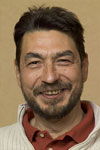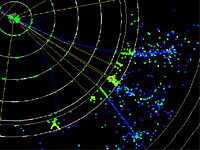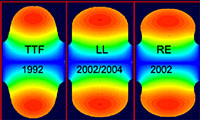 |
|
|
 |
Lecturers Selected for International Accelerator School for Linear Colliders

Carlo Pagani of INFN will lecture on ILC cryomodules. |

Andrei Seryi of SLAC will lecture on beam delivery. |
After more than two months of intensive work, the Curriculum Committee has selected a group of 21 lecturers from around the world to teach at the International Accelerator School for Linear Colliders. Scheduled for 19-27 May 2006, the school will take place at Sokendai, Graduate School for Advanced Studies in Hayama, Japan.
"We have a strong team of lecturers with a good balance between young and senior physicists.", said Weiren Chou, one of the school’s organizers and Chair of the ICFA Beam Dynamics Panel. "We also have a nice geographical distribution among the three regions – Asia, Europe and North America. We also maintained a balance between various institutions."
With topics ranging from damping ring basics, taught by Susanna Guiducci of INFN-LNF, to detectors, taught by Hitoshi Yamamoto of Tohoku University, to conventional facilities, taught by Vic Kuchler of Fermilab, students who attend the accelerator school will receive a complete education in linear colliders.
Read more...
-- Elizabeth Clements
|
 |
|
|
 |
|
Upcoming meetings, conferences, workshops
Open Symposium on European Strategy for Particle Physics
LAL, Orsay, France
30 January-1 February 2006
ATF2 Project Meeting
SLAC
3-5 February 2006
LET Meeting
CERN
8-11 February 2006
LLRF Hardware Development Workshop (rtf)
FNAL
9-10 February, 2006
RDR Meeting
FNAL
13-14 February, 2006
EUDET Kick-Off Meeting
DESY
15-17 February 2006
ILC GDE Meeting
Bangalore, India
9-11 March, 2006
LCWS 2006
Bangalore, India
9-13 March 2006
International Symposium on Detector Development in Particle and Astroparticle Physics and Synchrotron Radiation
SLAC
3-6 April 2006
NSF/DOE Review
ILC - Americas
FNAL
4-6 April 2006
International Accelerator School for Linear Colliders
Sokendai, Graduate School for Advanced Studies
Hayama, Japan
19-27 May 2006
CALOR 2006
12th International Conference on Calorimetry in High Energy Physics
Chicago, USA
5-9 June 2006
ALCPG Meeting
Vancouver, Canada
19-23 July 2006
ILC GDE Meeting
Vancouver, Canada
19-23 July 2006
|
|
 |
 |
|
|
 |
Algorithms Flow at Detector Simulation Workshop

Full event reconstruction with a particle flow algorithm.
|
Last month in Boulder, Colorado, about 30 scientists shared ideas and worked together on software problems at the American Linear Collider Physics Group Detector Simulation Workshop.
"This was a software mini-workshop.", said SLAC's Norman Graf who was a member of the workshop's Organizing Committee, together with Uriel Nauenberg and Stephen Wagner of the University of Colorado and Anthony Johnson of SLAC. "The goal is to provide an informal atmosphere for people to get together and exchange ideas. We try to get the experts together with the software users in an informal atmosphere, and ask questions, brainstorm and do some design work. This workshop was particularly nice because we had a large number of graduate and undergraduate students from the University of Colorado attend."
The Detector and Simulation working group within the American Linear Collider Physics Group (ALCPG) is currently developing simulation and event reconstruction software to be used in a generic linear collider detector work environment. "We have been tasked with an extremely ambitious goal to have complete simulation and reconstruction software working ten years before the machine is built.", Graf said. "A lot of experiments don't do that until right before the data arrives. We are trying to design the detector using the results of the simulations. Our motivation is to build the best possible detector. This is a very expensive endeavour, and we want to squeeze the most physics out of it."
Read more...
-- Elizabeth Clements |
 |
|
|
 |
The Events in the Period of Chinese New Year 2006
The first day of the 2006 Chinese New Year was on 29 January 2006. Following the 6 January announcement that an international research collaboration observed a resonant state at the upgraded Beijing Spectrometer (BESII), scientists celebrated very good news at this important Chinese festival. The discovery, which was reported in the 31 December 2005 issue of the Physical Review Letters, has aroused broad interest from the global high-energy physics community (detailed report). We believe that more interesting discoveries could be found in BES-III of BEPC-II, which is under construction at IHEP, Beijing, China.
Read more...
-- Jie Gao
|
 |
|
|
 |
|
From Science @ Berkeley Lab
30 January 2006
Looking Toward TeV
Theoretical physicist Hitoshi Murayama is an optimist. Contemplating a
discipline that many think is fragmenting into ever more pieces, like a
smashed vase with shards labeled "dark energy," "antineutrinos," "hidden dimensions," "charge-parity violation," "supersymmetry," and the like, Murayama sees physics coming together instead.
Read more...
|
|
 |
 |
|
|
 |
R&D Board

TESLA Superconducting RF cavity shape (left) and two alternate shapes under study in the ILC R&D program. |
A decade or so ago, the thought of building a TeV scale linear collider was pretty much just a romantic notion. The long extrapolations from present accelerators and from proven technologies were daunting. But, mostly as a direct result of more than a decade of enormously successful and impressive R&D, we are now able to undertake a serious design effort toward such a machine. The basic technologies that will be needed in a linear collider have been demonstrated, especially the superconducting RF technology which will be the basis of the main linac.
This highly successful ILC R&D program continues to be primarily supported regionally by the major high energy physics laboratories throughout the world. Considering the successes of the program as it is presently being carried out, one might wonder whether or what role the GDE should assume in coordinating this R&D program? First, we need to recognize that the needs for R&D in the development of a linear collider design are far from finished. In fact, the continuing and future R&D programs will be absolutely crucial for demonstrating critical elements of the design, optimizing it with respect to cost and performance, and finally evolving it as technologies improve, so that we can build the best possible machine when the ILC is constructed.
To insure that the ILC R&D maximally supports our design efforts, the GDE must provide global guidance for the program, set priorities, justify overlaps and identify gaps in the program. For these reasons, I created an R&D Board at the Frascati GDE meeting in December. Previously in this column, I described the other two boards (Design Cost Board and a Change Control Board) that I appointed with missions related to guiding, reviewing and documenting our global design effort toward a reference design this calendar year
Read more...
--Barry Barish
Director's Corner Archive
|
 |
|
|
 |
|
SMTF Meeting Notes Available
The SMTF meeting notes from 19 January are posted online along with the presentations. Go to the Fermilab ILC document server and
select 19 January meeting.
Read more...
Registration for Bangalore Workshop
There has been some confusion about registering for the GDE meeting in Bangalore. If you are attending the GDE meeting, you must also register for the LCWS. All food, shuttles and other services are covered by the registration fee for the LCWS. If you have any questions about registration, please contact Maxine Hronek.
Correction
Last week's issue of NewsLine affiliated Joachim Mnich with the wrong institution. Mnich is a particle physicist at DESY. NewsLine regrets the error.
ILC Related Preprints
28 Jan 2006
Studying the Triple Higgs Self-Coupling Via e+e- --> b bar b HH, t bar t HH
at Future Linear e+e- Colliders
physics/0601204
26 Jan 2006
Studies for a Photon Collider at the ILC
|
|

